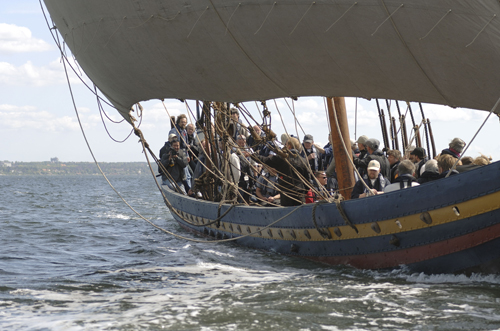But the seasickness is feared amongst sailors. It is a disorder, that humorously is called ’delirium nauticus’, but most of us know it as seasickness.
There are many stories about people at sea, suffering so severely from seasickness that they are willing to inflict damage on themselves or the ship to relieve their pain. Some of the stories might be urban legends and not have much truth in them, but they add to the entertainment on the mystical life at sea.
What we do know is that seasickness, which is related to airsickness and carsickness can be extremely unpleasant and strike any person on board a ship.
Seasickness begins in the ear
The cause of seasickness is a disturbance in our balance centre in the brain.
The balance centre constantly receives information from our sight and the balance organ in the inner ear. The balance organ only grasps fast movements and has difficulties reporting slow movements to the brain, like when a boat is rocking or a car is turning. But the slow movements can on the other hand be perceived by our eyes. The contradicting information leads to a conflict between the senses in our brain and that conflict cause’s motion sickness.
When the balance centre in the brain has experience with the movements it’s exposed to, one can easier endure it. As an example: the more you sail, the less seasick you get.
Most of the young women got seasick
Susanne Malmstrøm is the nurse on board the Sea Stallion and it’s her job to take care of any sick crew members. In advance she expects that seasickness will be the one disorder most commonly experienced by crew members on the 7 weeks of sailing from Roskilde to Dublin:
”When we sailed to Norway last summer, we learned a bit about the disorder. Despite the nice weather there were almost thirty cases of seasickness on board, mostly occurring during moderate to fair wind conditions. Only a few crew members were throwing up, but eight out of ten, experienced nausea and half the people affected had symptoms such as dizziness and tiredness,” says Susanne Malmstrøm.”
Her statistics show that especially the young women on board got seasick.
”That fits with the experiences of seasickness on other ships. The older you get, the more resistant to seasickness you become.”
Real heroes do not become sick
At the Viking Ship Museum scholars have tried to find out how they experienced seasickness in the past. But there is nothing in the sagas on seasick Vikings. Heroes simply don’t get sick and if they did, they probably wouldn’t admit to it.
It’s not quite like that on a Viking ship A.D. 2007. When the Sea Stallion sails 1.700 kilometres through the North Sea to the rough waters North of Scotland and down along the Irish coast seasickness amongst the crew will be written down in detail. That way the scholars back home can give an estimate on the number of crew members who were unfit to sail or fight due to motion sickness.
Tips on seasickness:
• Do not eat a lot before sailing
• Sit still or lie down.
• Make sure you get fresh air
• Avoid smoking or drinking alcohol
• Move into the center of the ship.
• Avoid reading
• Look at one steady point or close your eyes.



